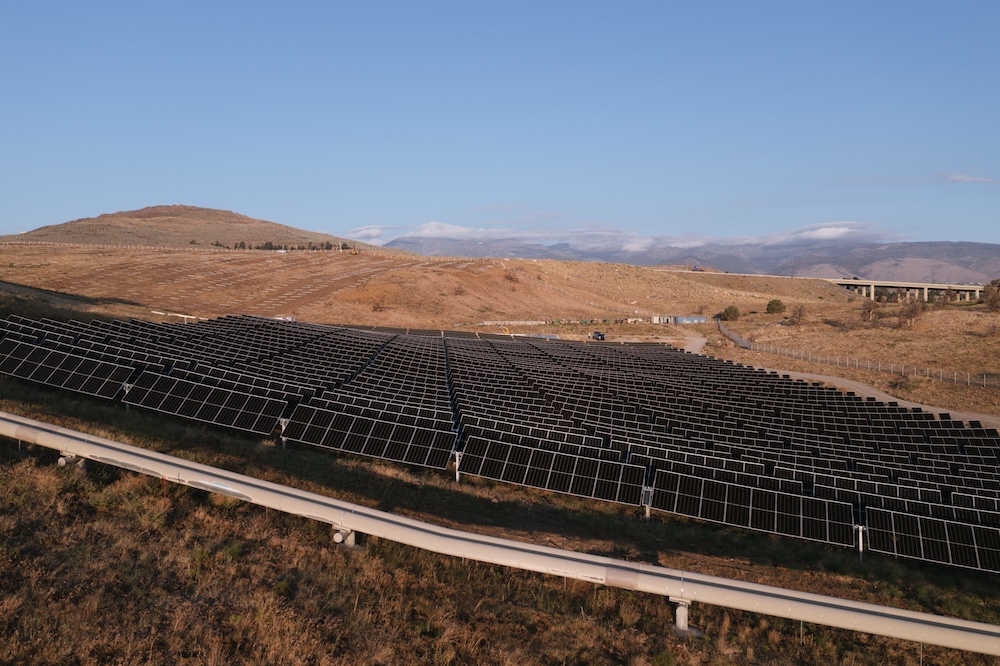Washouts, Protests, & Delays: How To Beat Solar Grading Risks
The use of solar energy has undoubtedly reduced the environmental impact of using fossil fuels in large-scale power generation. However, when it comes to utility-scale and commercial solar projects, there’s a common practice that’s been proven to not only negatively impact the environment, but also cause permitting issues, lawsuits, construction delays, and more. That practice is called mass grading.
In this blog, we’ll explain more about the downsides of grading and real examples of grading gone wrong. We’ll also introduce ideas to limit the need for the process with new, exciting solar tracking technology like the Nevados All Terrain TrackerⓇ.
What Is Solar Site Grading?
Solar site grading is the land-leveling process used in large-scale solar projects to create a planar or flat surface. It involves stripping vegetation and land to shear off high points on a development project and using the graded soil to fill low points and create an even ground.
Why Is Grading Used in Large-Scale Solar Projects?
In order to build commercial- and utility-scale solar farms with standard solar equipment, developers and EPCs need large plots of flat, undeveloped areas — also known as greenfield land. However, as the amount of available greenfield land shrinks, crews are forced to build on uneven ground that’s not ideal for solar. Thus, grading is used to level out these areas so they’re suitable for construction. Although the mass grading process seems like a good solution, it comes with a long list of downsides.
Downsides and Risks of Solar Grading
Solar grading is a big variable in solar risk management. It brings several downsides and risks that can affect the cost of a utility-scale solar project, have legal implications, and possibly result in project delays or cancellations. It can also cause environmental damage, considering the extent of soil excavation involved, which can lead to erosion and washouts. Here’s a detailed look at the downsides and risks of solar site grading:
Added Costs
Mass grading is no simple process, and in most cases, it significantly raises the cost of any solar project it’s used on. This additional cost is due to the required permitting process and the actual site stripping (called cutting) and filling itself. EPC and O&M firms may also incur additional costs through the revegetation procedures needed after grading to mitigate its environmental effects and stabilize the soil. Not only that, potential lawsuits from runoff into neighboring properties or waterways during or after project completion can contribute to even more unforeseen costs.
Construction Delays
Developers and EPC firms undertaking utility-grade solar projects should involve neighboring communities and local permitting authorities to ensure they adhere to environmental conservation standards. Solar grading can raise strong objections from local communities when it violates the land’s agricultural capacity and vegetation. As a result, project construction can be pushed back months or even years due to civilian pushback.
Additionally, grading and revegetation are best performed during warmer months with little to no rain; if these conditions are not possible, it can push back the entire construction timeline.
Environmental Damage
Large-scale solar grading requires extensive land clearing and the removal of existing soil and vegetation. This can lead to increased erosion and runoff due to changing site drainage and loose topsoil. Grading can also damage the habitats of surrounding wildlife.
Permits and Legal Issues
As the solar industry grows, local and federal authorities are becoming more concerned over the impact of associated activities like grading. Solar developers and EPC firms now have to follow zoning regulations that restrict certain grading activities on project sites. They must also adhere to specific erosion and sediment control during grading and site maintenance.
Meeting these regulations and acquiring subsequent permits may take a long time, and can even result in project cancellation if the requirements make the project overly expensive to implement. Additionally, closing out permits typically requires 80% or more revegetation which can prove challenging after topsoil disruption. This has been responsible for multi-year delays in closing out permits which often delays EPC final payment.
Grading Gone Wrong: Real Examples of the Impact of Mass Grading
The negative impacts of solar grading have already presented themselves in numerous utility-scale projects. From lawsuits and protests to significant environmental damage, read on to see how mass grading is causing trouble for solar risk management.
Case Study 1: Utility-Scale Solar Project Facing Long-Term Delays
Sometimes, solar developers face significant delays due to mass grading, which can prevent them from using completed solar farms for months or even years.
In the case of one solar developer, grading on their project site has severely damaged the soil and prevented them from regrowing vegetation after construction. Revegetation on project sites is a requirement to close out permits and begin using the solar farm, so the developer has faced delays for several years — and there’s no end in sight.
Case Study 2: Utility-Scale Solar Developer Sued Due To Violating Federal and State Water Protection Laws
In April 2020, a lawsuit was filed in the U.S. District Court against a major solar developer. The lawsuit alleged that the developer had violated federal and state water protection laws through their 4-megawatt solar energy project. According to the lawsuit, the project site was a former sand and gravel pit, and its construction resulted in irreparable harm to nearby wetlands and rivers.
Case Study 3: Online Pushback: Solar Expansion Projects Across the U.S. Halted Due to Social Media Protests
Public protests due to mass grading can derail solar projects, sometimes causing long construction delays or even total cancellation. This can happen online, too, which was proven in a recent report by Reuters that discovered a fast rise of anti-grading communities on social media protesting large-scale projects.
The report found over 45 organized online groups actively protesting local solar projects that they felt were threatening their homes, communities, and the environment. These protests had some dramatic effects on current projects using grading; in 2021, they led to the cancellation of 1.7 gigawatts of proposed solar capacity while in the permitting stage. As greenfield land shrinks and the need for grading rises, these protests and delays are likely to get even more prominent.
How Nevados Is Beating Solar Grading With the All Terrain TrackerⓇ
The evidence is clear — solar grading on large-scale solar projects without a doubt causes adverse environmental damage. In many cases, this can lead to prompt lawsuits and protests from conservationists and neighboring communities. It can also result in additional costs, construction delays, and even the discontinuation of projects.
At Nevados, we’ve proposed a solution to the grading problem: the All Terrain Tracker® (ATT®). This state-of-the-art solar tracker eliminates the need for solar grading through the use of articulating bearings and non-continuous torque tubes. As a result, the All Terrain Tracker® can handle overall slopes of up to 37% in any direction and angle changes at each foundation of up to 26%.
Contact us today to learn more about the ATTⓇ and how it can help you cut costs for your utility-scale solar project while streamlining permitting and construction.



